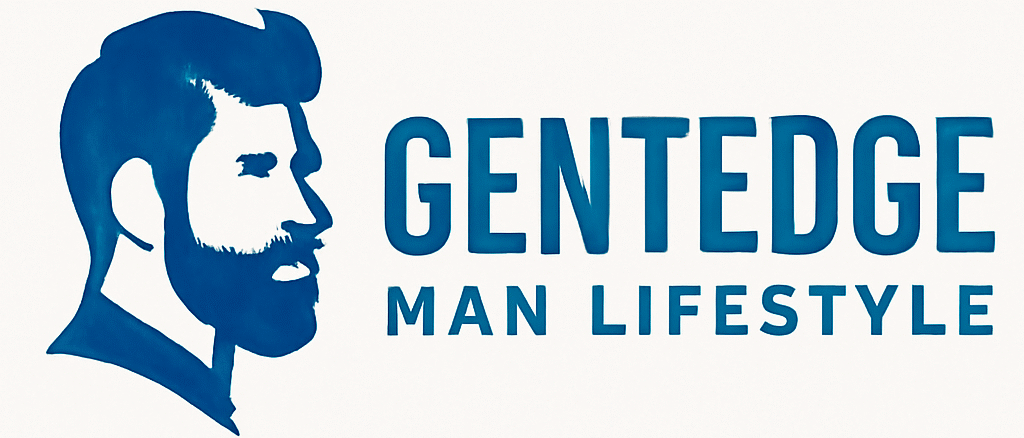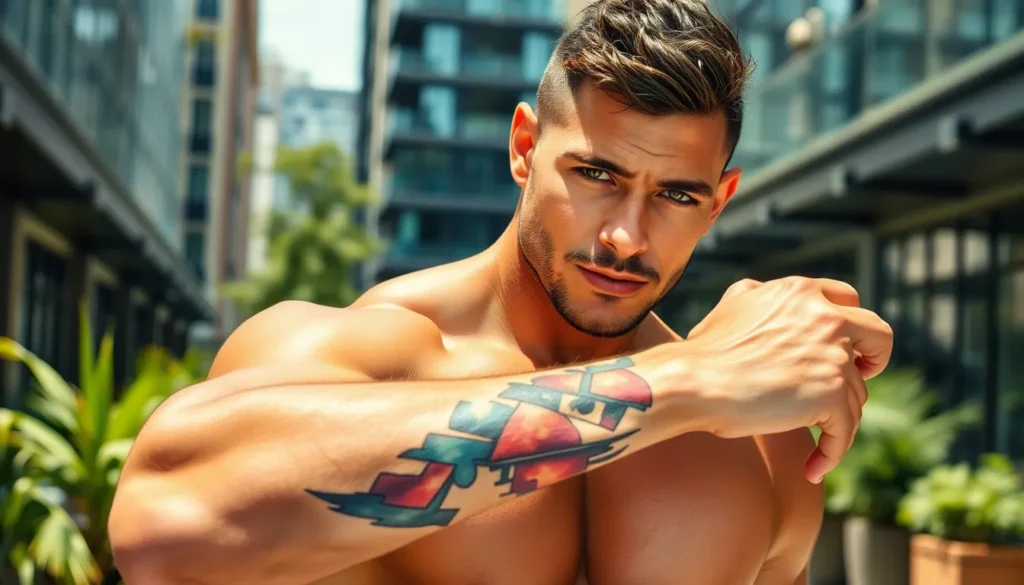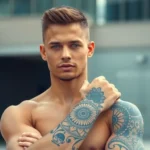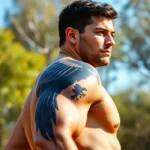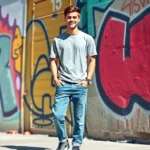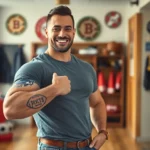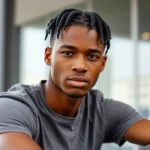Abstract tattoos have revolutionized the way men express themselves through body art. These non-representational designs break free from traditional imagery and embrace flowing lines, geometric patterns, and artistic interpretations that speak to the soul. We’re seeing more men choose abstract tattoos because they offer limitless creative possibilities and deeply personal meaning.
Unlike conventional tattoos that depict exact objects or symbols, abstract designs let you tell your story through color, form, and movement. They’re perfect for men who want something unique – artwork that can’t be replicated or categorized into typical tattoo genres. Whether you’re drawn to minimalist geometric shapes or bold splashes of color, abstract tattoos offer sophisticated versatility.
The beauty of abstract tattoo designs lies in their ability to evolve with you. What starts as one interpretation can take on new meanings throughout your life, making these tattoos incredibly personal and timeless. We’ll explore the most striking abstract tattoo ideas that’ll help you create a masterpiece on your skin.
Understanding Abstract Tattoo Art and Its Appeal for Men
Abstract tattoo art breaks away from literal representations to create designs that speak through pure visual elements. We’ll explore what defines this captivating art form and why it resonates so strongly with modern men.
What Makes a Tattoo Design Abstract
Abstract tattoo designs eliminate recognizable objects to focus on fundamental visual elements like shape, color, and texture. These tattoos don’t attempt to represent exact items from the real industry but instead create meaning through composition and flow.
Geometric patterns form the backbone of many abstract designs, featuring intersecting lines, triangles, circles, and complex polygonal structures. Artists combine these shapes in unexpected ways to generate visual tension and balance.
Flowing organic forms represent another approach to abstract tattooing, incorporating wave-like movements, cellular structures, and biomorphic shapes that suggest natural processes without depicting them directly. These designs often feature smooth gradients and seamless transitions between elements.
Color relationships play a crucial role in abstract tattoos, with artists using complementary hues, analogous palettes, or monochromatic schemes to evoke exact emotions and create depth without relying on shading techniques alone.
Why Men Choose Abstract Over Traditional Designs
Personal expression drives many men toward abstract tattoos because these designs allow for deeper individual interpretation and meaning. Unlike traditional tattoos with established symbolism, abstract pieces let each person assign their own significance to the artwork.
Professional considerations influence decision making as abstract tattoos can appear more sophisticated and less controversial in workplace environments. These designs often read as artistic statements rather than subcultural markers.
Uniqueness appeals to men seeking distinctive body art that won’t be replicated elsewhere. Abstract designs offer infinite possibilities for customization, ensuring that each tattoo remains truly one of a kind.
Aesthetic versatility attracts men who appreciate how abstract tattoos complement different clothing styles and personal aesthetics. These designs can appear minimal and sophisticated or bold and dramatic depending on the execution.
Timeless quality emerges from abstract designs because they don’t rely on current trends or pop culture references that might feel dated in future years. The fundamental visual principles remain consistently appealing.
The Artistic Freedom of Abstract Expression
Creative collaboration between artist and client reaches new heights with abstract tattoos, as both parties can experiment with unconventional approaches to composition, color, and form without being constrained by realistic representation.
Technical innovation flourishes in abstract tattooing, with artists developing new shading techniques, color blending methods, and linework styles that push the boundaries of what’s possible in permanent body art.
Emotional resonance develops organically through abstract designs that can evolve in meaning as the wearer’s life experiences change. These tattoos often reveal new interpretations and connections over time.
Scale flexibility allows abstract elements to work effectively in both large statement pieces and smaller accent tattoos, making this style accessible regardless of desired size or placement on the body.
Integration opportunities expand when working with abstract designs, as these elements can seamlessly connect with existing tattoos or be designed to complement future additions to create cohesive body art collections.
Geometric Abstract Designs That Command Attention
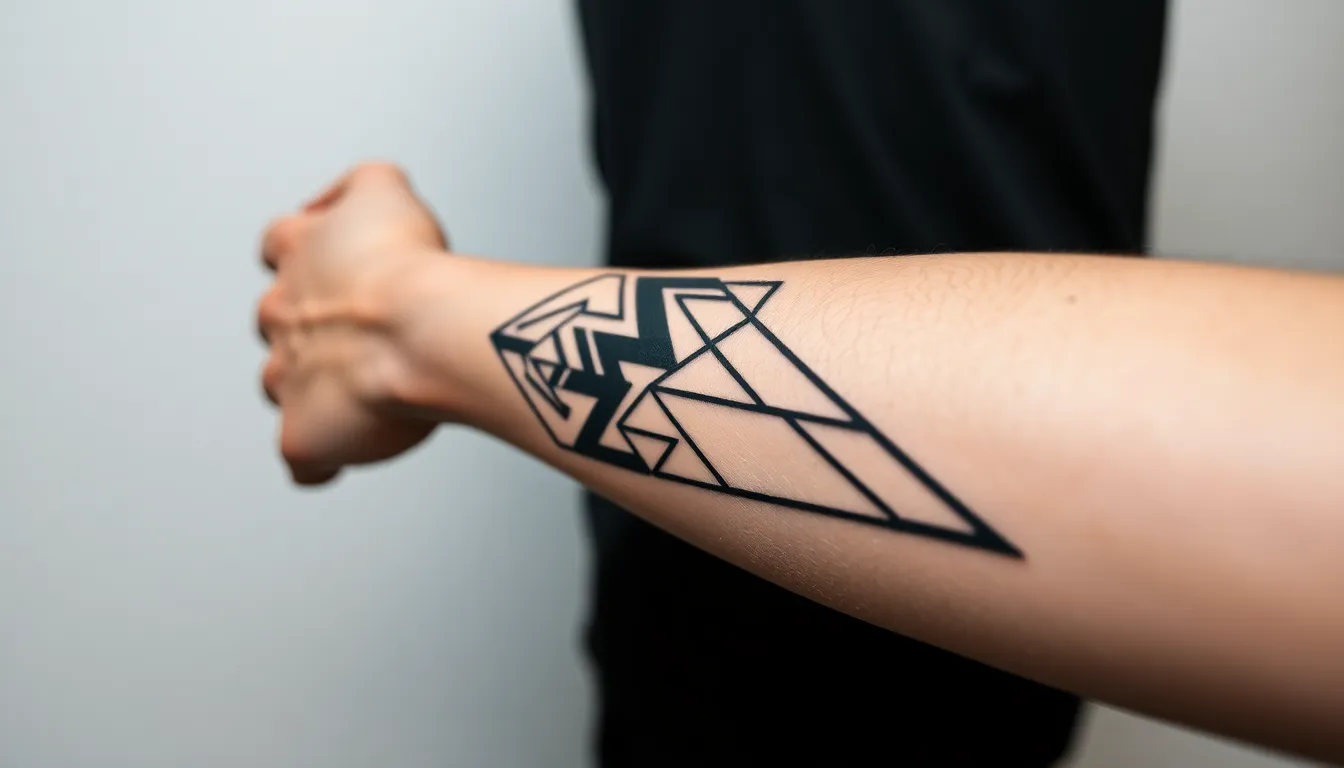
Geometric abstract patterns create some of the most visually striking tattoo designs for men through their precision, symmetry, and bold contrast. We’ve seen these designs gain tremendous popularity as they combine mathematical beauty with personal expression.
Angular Patterns and Sharp Lines
Angular patterns dominated contemporary men’s tattoo choices because they create clean, modern looks that accentuate masculinity. We find these designs draw inspiration from technical drawings and architectural blueprints, resulting in crisp lines that make powerful visual statements.
Sharp lines form the backbone of these geometric compositions, using elements like triangles, hexagons, and interlocking patterns to evoke order or chaos within a single design. Blackwork techniques enhance the clarity and impact of each line, while negative space adds depth and dimension to the overall composition.
Technical precision defines these angular designs, with artists using straight edges and calculated angles to create patterns that appear almost mechanically perfect. We recommend considering placement on areas like the forearm or shoulder blade where clean lines can be properly showcased without distortion.
Sacred Geometry Interpretations
Sacred geometry interpretations infuse tattoos with deeper spiritual symbolism through ancient mathematical principles. We see designs featuring the Flower of Life, Metatron’s Cube, and Sri Yantra representing concepts like unity, balance, and the universe’s fundamental structure.
These geometric patterns appeal to men seeking connection to higher ideals or metaphysical beliefs through their body art. Detailed, repeating patterns create intricate designs that reward closer inspection while maintaining visual impact from a distance.
Spiritual significance drives many of these tattoo choices, with each geometric form carrying exact meanings rooted in various cultural traditions. We find that these designs often serve as personal meditation tools or reminders of one’s spiritual journey.
Minimalist Geometric Compositions
Minimalist geometric compositions strip designs down to their essential elements, focusing on simplicity and elegance over complexity. We appreciate how these understated approaches allow for subtle self-expression without overwhelming visual clutter.
Small, thoughtful arrangements of basic shapes create powerful statements through their restraint and precision. These designs work particularly well on the chest, upper arm, or forearm where their clean lines can be properly appreciated.
Expandability makes minimalist geometric tattoos especially appealing, as they can easily grow into larger sleeves or integrate with other design elements over time. We recommend starting with a simple geometric foundation that can evolve as your tattoo collection develops.
Watercolor Abstract Tattoos for Creative Expression
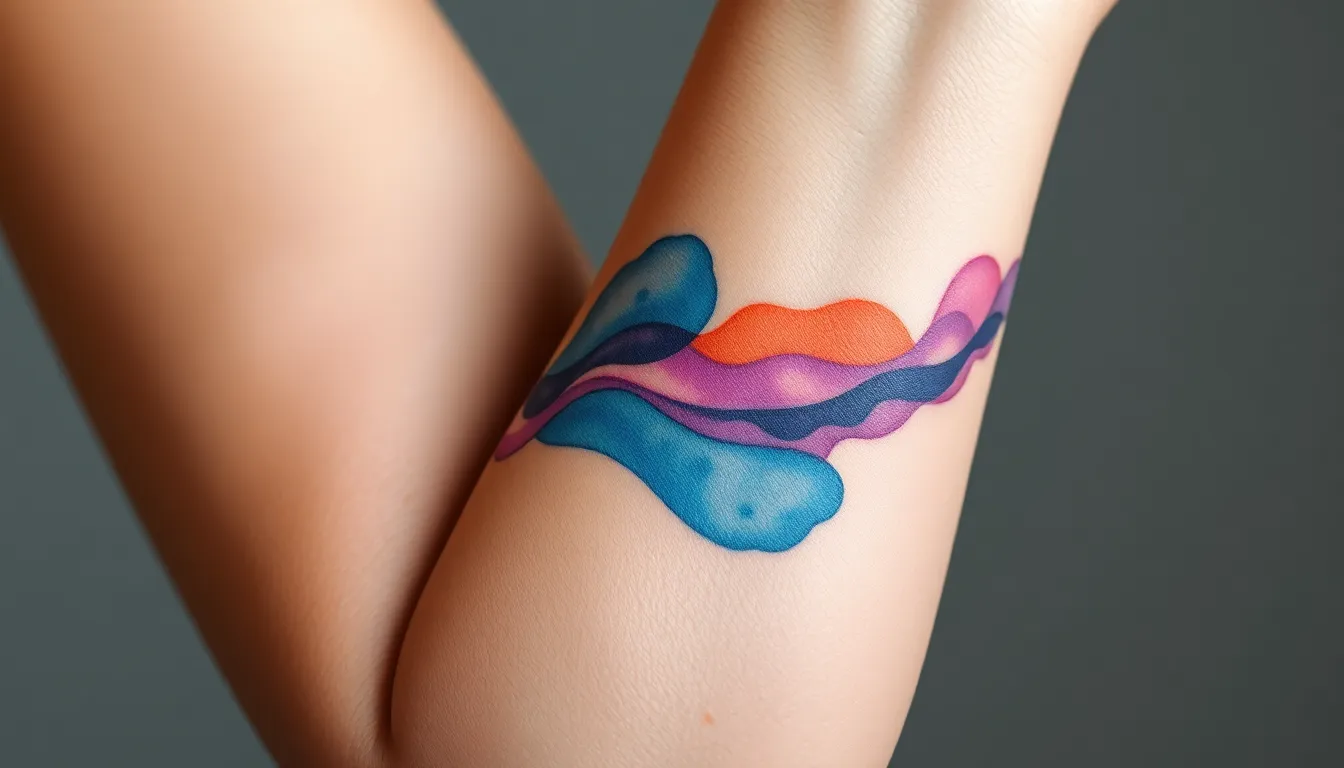
Watercolor abstract tattoos offer men an expressive canvas that mimics the fluid beauty of traditional watercolor paintings. These designs break conventional tattoo boundaries by embracing organic movement and vibrant color transitions.
Splash and Drip Techniques
Splash techniques create ever-changing energy through spontaneous color bursts that appear to flow naturally across the skin. Artists apply ink in controlled splashes that radiate outward from focal points, generating movement that feels both intentional and organic. Drip effects complement these splashes by adding vertical elements that suggest gravity’s natural pull on wet paint.
We see these techniques working particularly well on larger canvas areas like the shoulder blade or forearm where the design has room to breathe. Color droplets can cascade from geometric shapes or abstract forms, creating layers of visual depth. Professional tattoo artists often combine multiple splash patterns to build complex compositions that tell stories through color interaction.
Color Blending and Gradient Effects
Blending techniques transform harsh color boundaries into smooth transitions that mirror watercolor painting’s signature softness. Artists layer translucent inks to create depth while maintaining the ethereal quality that makes watercolor tattoos so captivating. Gradient effects flow from intense saturation to gentle washes, producing dimensional artwork that appears to glow from within the skin.
We recommend discussing color temperature combinations with your artist since warm and cool hues interact differently in tattoo applications. Purple melting into blue creates ocean depth effects, while orange transitioning to yellow generates sunset warmth. Multiple gradient layers can overlap to form complex color relationships that evolve as lighting conditions change throughout the day.
Abstract Landscapes in Watercolor Style
Industry interpretations in watercolor style capture natural scenes through impressionistic color washes rather than detailed line work. Mountain silhouettes emerge from purple and blue gradients while forest scenes flow through green color transitions that suggest rather than define exact trees. Ocean themes work exceptionally well with watercolor techniques since the medium naturally mimics water’s fluid movement.
We’ve observed that abstract watercolor landscapes often incorporate dreamlike qualities that make them deeply personal to each wearer. Desert scenes blend warm oranges and reds into dusty purples, creating otherworldly atmospheres. Sky compositions can stretch across larger body areas, with cloud formations suggested through white negative space and gentle color transitions that capture exact moods or memories.
Biomechanical Abstract Concepts for Modern Men

Biomechanical abstract tattoos represent the cutting edge of contemporary body art for men. These designs seamlessly blend technological innovation with natural forms to create truly unique expressions of modern masculinity.
Mechanical Elements Merged with Organic Forms
Mechanical elements merged with organic forms create some of the most striking abstract tattoos we see today. Artists combine intricate gears, pistons, and circuitry with flowing biological shapes like muscle fibers, vein networks, and cellular structures. These designs blur the boundaries between human anatomy and mechanical precision through sophisticated linework and dotwork techniques.
Stippling methods add incredible depth to these biomechanical pieces, allowing artists to create realistic textures that make mechanical components appear to emerge from beneath the skin. The interconnected patterns showcase how technology and nature can coexist harmoniously in a single design. Many men choose these tattoos because they represent the fusion of human strength with technological advancement.
Futuristic Abstract Machinery
Futuristic abstract machinery designs transport traditional mechanical concepts into tomorrow’s industry. These tattoos incorporate advanced components like holographic interfaces, energy conduits, and quantum processors rendered in abstract geometric forms. Artists use bold angular shapes and precise technical details to create the illusion of sophisticated machinery operating within the body.
Circuit board patterns flow seamlessly into abstract mechanical landscapes, suggesting advanced cybernetic enhancements. The designs often feature metallic gradients and electric blue accents that give the impression of active technology. We see these tattoos gaining popularity among men who work in tech industries or those fascinated by scientific advancement.
Cyberpunk Inspired Abstract Designs
Cyberpunk inspired abstract designs channel the dystopian future aesthetic that captivates modern men. These tattoos feature neon light trails, holographic glitches, and urban decay elements combined with abstract geometric patterns. Artists incorporate vibrant colors like electric pink, acid green, and digital blue against darker backgrounds to create that signature cyberpunk atmosphere.
Digital noise patterns and pixelated effects add authenticity to these futuristic designs, while metallic chrome elements reflect the industrial nature of cyberpunk culture. Bold lines intersect with fragmented shapes to suggest a industry where technology has evolved beyond current limitations. Many of these designs include subtle references to classic cyberpunk themes like data streams, virtual reality interfaces, and augmented reality overlays.
Abstract Animal and Nature Interpretations

Artists masterfully transform natural forms into abstract expressions that capture the essence of wildlife and landscapes without literal representation. These designs blend organic shapes with artistic abstraction, allowing personal symbolism and creativity to flourish through geometric patterns, watercolor effects, and surrealist elements.
Deconstructed Wildlife Silhouettes
Fragmented animal forms create powerful visual statements by stripping away anatomical details to emphasize pure movement and emotion. Artists use open outlines and negative space to suggest the spirit of creatures like wolves, eagles, or lions without depicting every feature. These minimalist compositions focus on the essential characteristics that make each animal recognizable while maintaining artistic freedom.
Modern interpretations often break silhouettes into geometric segments or flowing fragments that seem to dissolve and reform across the skin. The emphasis shifts from realistic representation to capturing the energy and personality of wildlife through strategic gaps and incomplete lines. This approach offers a contemporary alternative to traditional animal tattoos while maintaining deep symbolic meaning.
Abstract Tree and Forest Designs
Geometric lines and repeated patterns transform natural woodland scenes into striking artistic compositions that symbolize growth, connection to nature, and personal history. Simple line art interpretations might feature angular branches extending in mathematical progressions, while intricate large scale designs incorporate surrealist techniques to create dreamlike forest landscapes.
Root systems become abstract networks of intersecting lines that can flow seamlessly across different body areas. Canopy designs often use overlapping circular or triangular shapes to suggest leaves without depicting individual foliage, creating rhythm and movement through repetitive elements.
These compositions range from single stylized trees with geometric trunk patterns to entire forest scenes rendered through layered abstract shapes and negative space techniques.
Flowing Water and Wind Patterns
Ever-changing curved lines and strategic shading capture the fluid movement of natural elements through abstract shapes and overlapping strokes that suggest motion and energy. Water designs use wave like patterns that seem to flow naturally with body contours, creating tattoos that appear to move with the wearer.
Wind patterns emerge through sweeping gestural marks and directional line work that conveys invisible forces through visible artistic elements. Artists often combine thick and thin strokes to suggest varying intensities of movement, from gentle breezes to powerful gusts.
These designs offer versatility in emotional expression, with calm flowing patterns providing tranquil energy while more turbulent compositions suggest power and change. The abstract nature allows each viewer to interpret the movement according to their own experiences with these natural forces.
Typography and Abstract Lettering Combinations
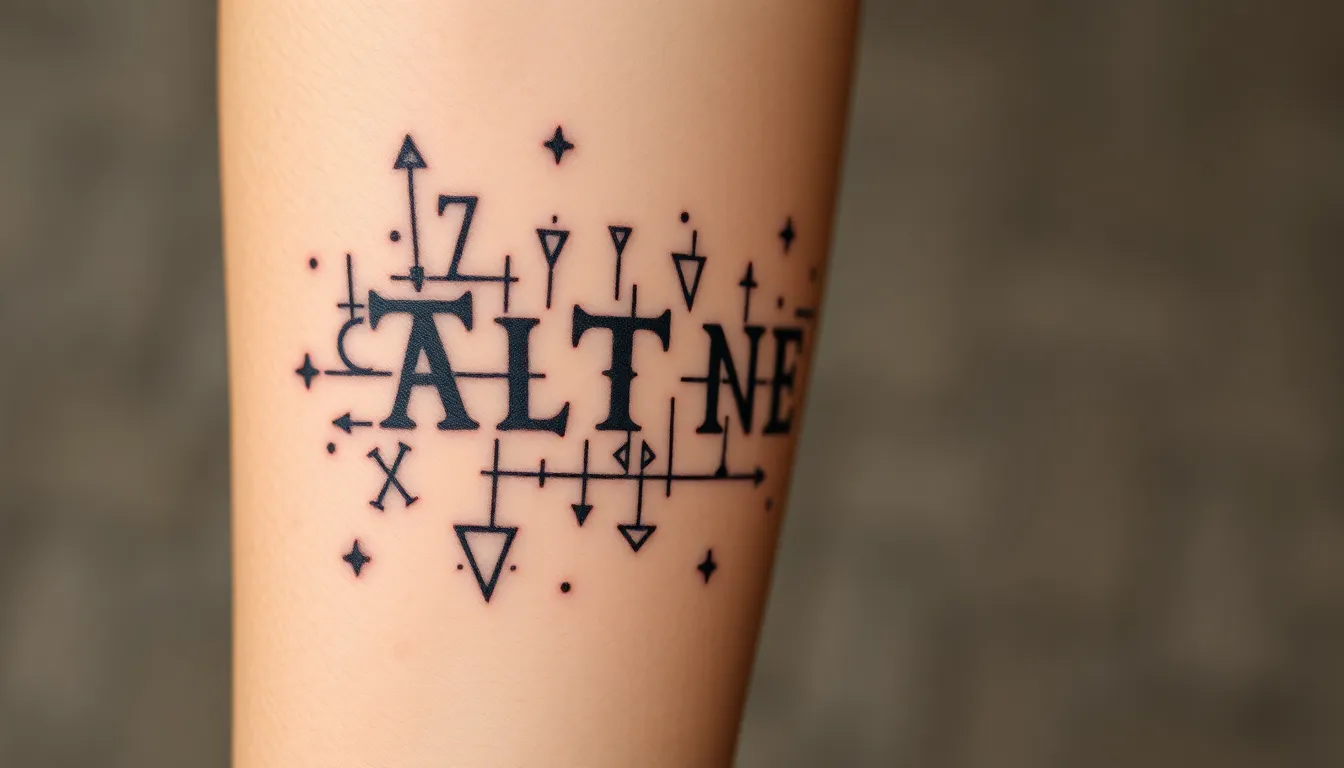
Typography meets artistic expression in abstract lettering designs that transform words into visual masterpieces. These innovative tattoos prioritize aesthetic impact over traditional readability, creating personalized statements that blend meaningful text with contemporary artistry.
Fragmented Text Designs
Fragmented text tattoos break conventional lettering into scattered pieces that create visual intrigue and symbolic depth. Artists intentionally separate words or individual letters, then overlay them with abstract shapes, geometric lines, and negative space elements. We see these designs symbolizing the complexity of human identity and thought processes through their deliberately broken strokes.
Movement becomes the defining characteristic as fragmented elements appear to flow across the skin in unexpected directions. The scattered nature of these tattoos allows for multiple interpretations, making each piece deeply personal to its wearer. Artists often integrate geometric patterns between the fragmented letters, creating cohesive designs that maintain visual balance even though their deconstructed appearance.
Popular placement areas include the forearm and shoulder blade, where the natural curves of muscle enhance the ever-changing flow of broken text elements.
Abstract Calligraphy Styles
Abstract calligraphy transforms traditional handwriting into contemporary art through dramatic distortions and artistic modifications. These designs twist, elongate, and fracture cursive letters while maintaining their fundamental flow and rhythm. Artists blend geometric precision with organic curves, creating typography that functions as pure visual art rather than readable text.
Negative space plays a crucial role in abstract calligraphy, highlighting exact portions of letters while obscuring others in artistic shadows. We observe how these tattoos merge cursive elegance with modern minimalism, appealing to men who appreciate sophisticated artistic expression. The flowing nature of abstract calligraphy pairs exceptionally well with watercolor techniques and gradient effects.
Traditional handwriting rules become creative suggestions rather than strict guidelines, allowing artists to emphasize emotional content over literal meaning. Each curve and angle serves the overall aesthetic vision while maintaining connection to the original letterforms.
Word Art with Geometric Elements
Word art embedded within geometric frameworks represents one of the most popular trends in men’s abstract typography tattoos. These designs place meaningful text inside precise shapes like triangles, circles, hexagons, and complex sacred geometry patterns including mandalas and Fibonacci spirals. The geometric structure provides visual anchor points that balance the organic flow of lettering.
Sacred geometry elements add spiritual symbolism to personal words and phrases, creating tattoos that resonate on multiple levels. Artists often use mathematical precision to ensure perfect symmetry between text and geometric borders, resulting in designs that appeal to men who value both rational structure and personal meaning.
| Geometric Element | Symbolic Meaning | Best Text Length |
|---|---|---|
| Triangle | Strength, stability | 1-3 words |
| Circle | Unity, wholeness | Single word or short phrase |
| Hexagon | Balance, harmony | 2-4 words |
| Mandala | Spiritual journey | Names or mantras |
These hybrid designs symbolize the union between logical thinking and emotional expression, making them particularly appealing to professionals in technical fields who still want meaningful personal tattoos. The structured framework allows for future expansion, as additional geometric elements can be added to create larger, more complex compositions over time.
Abstract Portrait and Face Designs
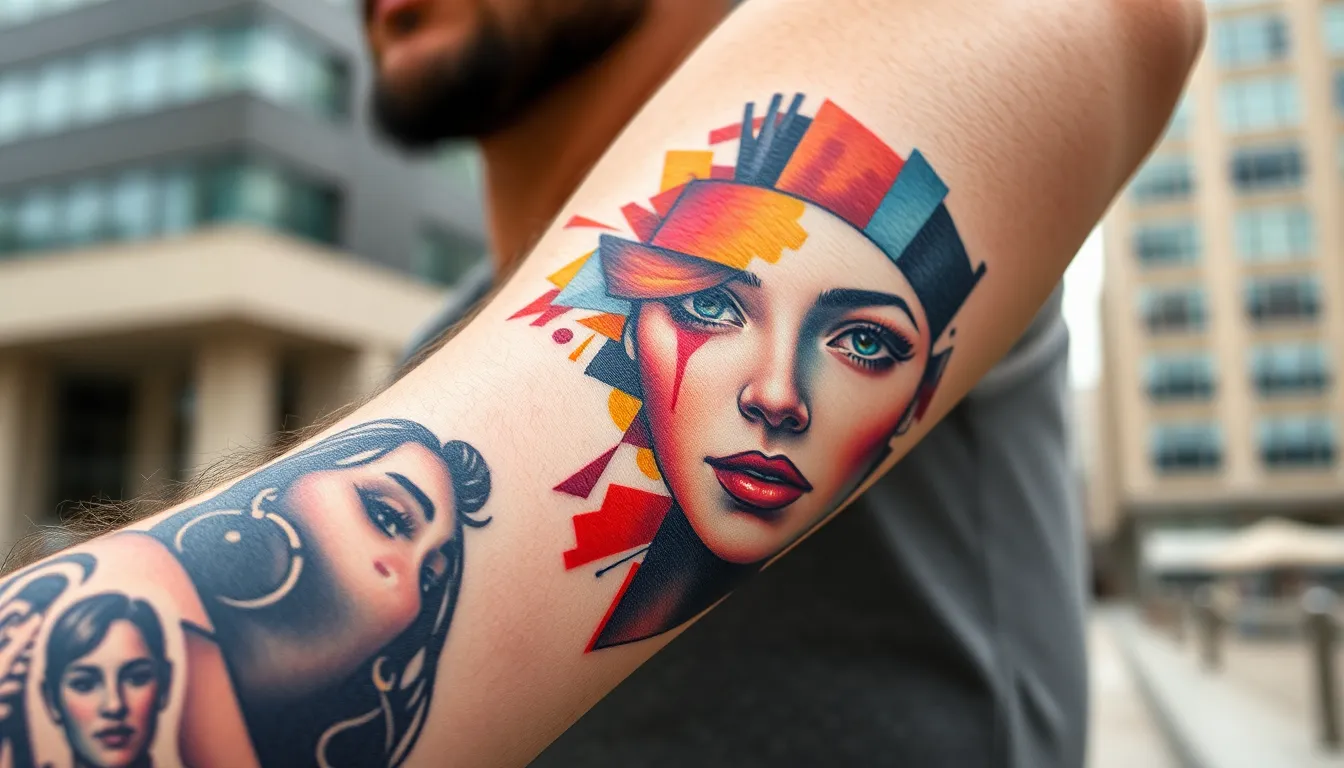
Abstract portraiture offers men a revolutionary approach to personal representation, transforming recognizable human features into powerful artistic statements. These designs challenge traditional portrait conventions while maintaining emotional resonance.
Fragmented Facial Features
Geometric shapes create compelling portrait interpretations by breaking down facial elements into triangular sections, circular forms, and linear patterns. Artists reconstruct eyes, noses, and mouths using mathematical precision, resulting in designs that suggest rather than directly depict human features. Watercolor techniques add fluidity to these fragmented compositions, allowing colors to bleed between geometric boundaries and soften harsh edges.
Negative space plays a crucial role in fragmented facial tattoos, with untattooed skin representing missing pieces of the portrait puzzle. This technique creates visual depth while encouraging viewers to mentally complete the image. Stippling and dotwork enhance textural contrast within fragmented sections, adding complexity to simplified geometric forms.
Placement strategies for fragmented facial features work exceptionally well on the forearm, shoulder, or back, where larger canvas areas accommodate the intricate interplay between positive and negative spaces.
Expressionist Portrait Styles
Distorted facial proportions characterize expressionist abstract portraits, emphasizing emotional intensity over realistic representation. Artists elongate features, exaggerate expressions, and manipulate proportions to convey psychological states rather than physical accuracy. Bold brushstroke effects translate traditional expressionist painting techniques into tattoo artistry, creating ever-changing movement within static designs.
Color psychology drives expressionist portrait choices, with vibrant reds suggesting passion, deep blues conveying melancholy, and golden yellows representing joy or enlightenment. These emotional palettes transform simple facial outlines into powerful psychological statements. Asymmetrical compositions challenge conventional portrait balance, reflecting the complex nature of human personality and internal conflict.
Layering techniques allow artists to build emotional depth through overlapping transparent colors and intersecting line work, creating portraits that reveal different aspects depending on viewing angle and lighting conditions.
Abstract Self-Representation Concepts
Personal symbolism transforms individual identity into abstract visual language, allowing men to express complex life experiences through non-literal imagery. These designs incorporate elements that hold deep personal significance, translating memories, values, or aspirations into geometric patterns, color relationships, and flowing forms. Sacred geometry interpretations can represent spiritual beliefs or philosophical principles through mathematical precision.
Evolutionary design potential makes abstract self-representation tattoos particularly appealing, as meanings can shift and deepen over time while the visual elements remain timeless. Artists often leave intentional spaces for future additions, allowing the tattoo to grow alongside personal development. Customization possibilities ensure each design remains unique, with artists incorporating exact colors, shapes, or patterns that resonate with individual personality traits.
Professional considerations make abstract self-representation ideal for men in corporate environments, as these designs maintain personal meaning while remaining aesthetically sophisticated and workplace appropriate.
Placement Considerations for Abstract Tattoo Designs
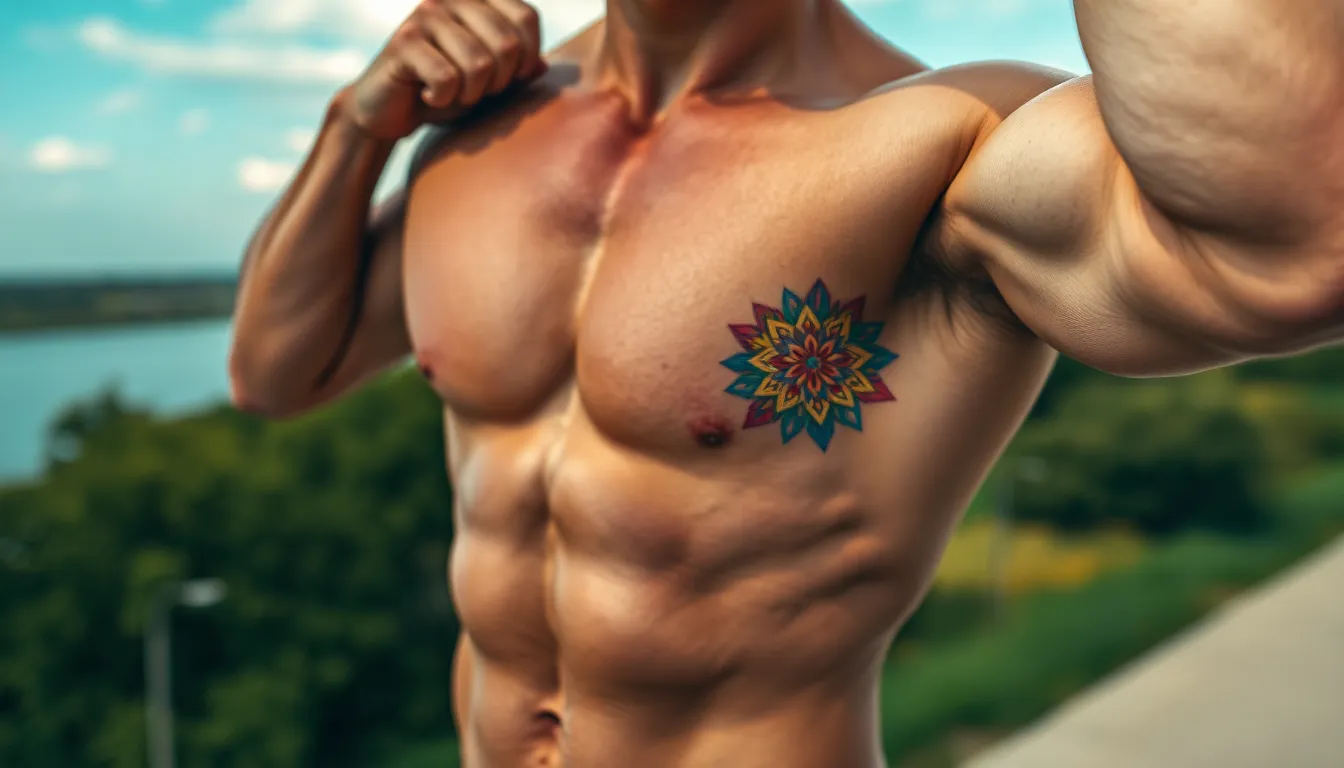
Selecting the optimal location for your abstract tattoo significantly impacts both its visual appeal and personal meaning. We’ll explore the strategic considerations that transform abstract designs from simple body art into powerful personal statements.
Best Body Areas for Abstract Art
Arms offer unmatched versatility for abstract tattoo placement, providing both visibility and artistic canvas space. Upper arms deliver flat surfaces perfect for detailed geometric patterns and complex color work, while forearms showcase your abstract art with maximum daily visibility. Shoulder areas work exceptionally well for circular or radial abstract designs that follow natural muscle contours.
Chest and torso locations create intimate canvases for meaningful abstract expressions. These areas accommodate larger compositions that can incorporate personal symbolism and emotional depth. Rib cage placements allow abstract designs to flow with your body’s natural lines, creating ever-changing visual movement.
Back placement provides the most expansive space for ambitious abstract projects. Full back pieces can incorporate multiple abstract elements that work together as unified compositions. Shoulder blade areas work perfectly for medium-sized abstract designs that remain easily concealable when needed.
Leg placements offer unique opportunities for abstract tattoo storytelling. Thigh areas accommodate large abstract compositions, while calf placements work well for vertical abstract designs that complement leg proportions.
Size and Scale Recommendations
| Body Area | Small Designs (2-4 inches) | Medium Designs (4-8 inches) | Large Designs (8+ inches) |
|---|---|---|---|
| Forearms | Abstract symbols, minimal geometry | Flowing patterns, color gradients | Sleeve integration pieces |
| Upper Arms | Simple geometric shapes | Complex angular patterns | Full arm compositions |
| Chest | Accent pieces | Central focal designs | Full chest coverage |
| Back | Shoulder blade details | Mid-back compositions | Full back masterpieces |
Small abstract designs work best on forearms, wrists, and behind ears for subtle artistic expression. These compact compositions focus on single abstract concepts like fragmented shapes or minimal color splashes.
Medium-sized abstract tattoos thrive on upper arms, chest areas, and calf locations. These scales allow for more complex abstract storytelling while maintaining clear visual impact and professional discretion.
Large abstract designs require substantial canvas areas like full back, chest, or thigh placements. Expansive compositions can incorporate multiple abstract elements, creating immersive artistic experiences that evolve as viewers examine different sections.
How Placement Affects Design Impact
Forearm placement maximizes daily visibility and social interaction with your abstract art. These locations showcase your artistic choices in professional and casual settings, making abstract designs conversation starters that reflect your creative personality.
Chest placement creates intimate personal connections with abstract symbolism. These designs remain private until you choose to reveal them, allowing for deeply meaningful abstract expressions that connect with your core identity.
Back placement transforms abstract tattoos into artistic statements revealed only in exact contexts. Beach settings, intimate moments, or artistic photography sessions become opportunities to showcase elaborate abstract compositions.
Shoulder and upper arm placements offer flexible visibility control depending on clothing choices. Tank tops reveal your abstract art, while business attire keeps designs professionally concealed.
Size and body area combinations determine viewer engagement levels. Large abstract pieces on visible areas command attention and artistic appreciation, while smaller designs on discrete locations create personal artistic connections without overwhelming social situations.
Choosing the Right Tattoo Artist for Abstract Work

Selecting the perfect artist transforms your abstract tattoo vision into reality. We’ll guide you through identifying specialists who excel in this distinctive art form.
Finding Artists Who Specialize in Abstract Styles
Research specialization by examining artists who specifically highlight abstract work in their portfolios. Many talented artists list their specialties on social media platforms and professional websites, making it easier to identify those who focus on non-representational designs.
Platform use becomes essential when discovering artists who excel in abstract styles. Instagram and Pinterest serve as powerful tools for showcasing recent work and allowing direct comparison of different artistic approaches. These visual platforms help you assess various interpretations of abstract tattoo art.
Style alignment ensures the artist’s interpretation of “abstract” matches your personal preference. Some artists focus on geometric precision, while others specialize in watercolor techniques, trash polka effects, or bold blackwork designs. Confirming this compatibility prevents disappointment during the design process.
Portfolio examination reveals whether artists can handle complex abstract concepts. Look for evidence of geometric patterns, flowing organic forms, and innovative use of negative space. Artists specializing in abstract work typically showcase diverse approaches ranging from minimalist compositions to intricate biomechanical interpretations.
Evaluating Portfolio Quality
High quality images provide the foundation for assessing an artist’s technical abilities. Professional portfolios feature clear, detailed photographs of completed tattoos with close-up shots and multiple angles. These visual elements help you examine line work precision and overall execution quality.
Consistency and detail demonstrate an artist’s mastery of abstract techniques. Look for solid blackwork application, clean fine lines, and effective use of negative space throughout their portfolio. Evidence of precise technique appears in geometric symmetry, smooth color transitions, and balanced composition across different abstract styles.
Diversity of designs indicates versatility and expertise in abstract tattooing. Portfolios displaying various abstract techniques from fine line work to bold patterns show the artist’s range and adaptability. This variety suggests they can handle different abstract concepts and customize designs according to your exact vision.
Technical proficiency becomes evident through examining stippling techniques, gradient effects, and color blending quality. Abstract tattoos often require advanced skills in layering translucent inks and creating depth through visual contrast. Artists with strong portfolios demonstrate these capabilities consistently across their work.
Communication and Design Collaboration
Clear communication ensures your abstract tattoo concept translates accurately from vision to skin. Effective artists listen carefully to your design ideas and provide honest feedback about feasibility and optimal placement. This transparency prevents unrealistic expectations and ensures successful outcomes.
Collaboration process reveals how artists work with clients during the design phase. Many experienced abstract tattoo artists offer preliminary sketches, digital mockups, or detailed consultations before beginning the actual tattoo work. This collaborative approach allows for refinement and ensures mutual satisfaction with the final design.
Customization capabilities distinguish exceptional abstract tattoo artists from average practitioners. Abstract designs often require important adaptation and iteration to achieve the desired result. Artists experienced in abstract styles typically embrace this creative process and remain open to modifying concepts throughout development.
Design iteration demonstrates an artist’s commitment to achieving your vision. Professional abstract tattoo artists understand that these non-representational designs may require multiple revisions to capture the intended aesthetic and emotional impact. Their willingness to refine concepts shows dedication to delivering personalized, meaningful artwork.
Conclusion
Abstract tattoo designs represent the perfect intersection of artistic innovation and masculine self-expression. We’ve explored how these versatile designs transcend traditional boundaries while offering endless possibilities for personal storytelling.
The journey from geometric precision to watercolor fluidity demonstrates that abstract tattoos aren’t just trending – they’re reshaping how men approach body art. Whether you’re drawn to biomechanical complexity or minimalist elegance these designs adapt to your lifestyle and evolve with your story.
The key lies in finding an artist who understands your vision and choosing placement that maximizes both impact and meaning. With proper research and clear communication your abstract tattoo will become a unique masterpiece that reflects your individuality for years to come.
Frequently Asked Questions
What makes abstract tattoos different from traditional tattoos?
Abstract tattoos focus on non-representational designs using shapes, colors, and patterns rather than depicting specific images. They offer limitless creative possibilities and can evolve in meaning over time, unlike traditional tattoos that show recognizable objects or symbols.
Why are men increasingly choosing abstract tattoos?
Men choose abstract tattoos for personal expression, professional considerations, uniqueness, aesthetic versatility, and timeless quality. These designs allow for creative collaboration with artists and offer flexibility in scale and integration with existing tattoo collections.
What are geometric abstract tattoos?
Geometric abstract tattoos feature precision, symmetry, and bold contrast through angular patterns and sharp lines. They often incorporate sacred geometry interpretations with spiritual symbolism or minimalist compositions that emphasize simplicity and elegance.
What are watercolor abstract tattoos like?
Watercolor abstract tattoos mimic traditional watercolor paintings with fluid beauty. They use splash and drip techniques, color blending, gradient effects, and often feature abstract landscapes captured through impressionistic color washes rather than detailed line work.
What are biomechanical abstract tattoos?
Biomechanical abstract tattoos blend technological innovation with natural forms, merging mechanical elements like gears and circuitry with organic shapes. They create unique expressions of modern masculinity by blurring lines between human anatomy and mechanical precision.
Can abstract tattoos incorporate text and lettering?
Yes, typography and abstract lettering combinations transform words into visual masterpieces. This includes fragmented text designs, abstract calligraphy styles, and word art embedded within geometric frameworks, prioritizing aesthetic impact over traditional readability.
What should I consider for abstract tattoo placement?
Placement significantly impacts visual appeal and personal meaning. Arms, chest, back, and legs are ideal locations. Consider size and scale recommendations – forearm tattoos maximize visibility while chest and back placements create intimate personal connections.
How do I choose the right artist for abstract tattoos?
Research artists who specifically highlight abstract styles in their portfolios using platforms like Instagram and Pinterest. Evaluate their technical abilities, consistency, and ensure style alignment between their interpretation and your preferences for successful collaboration.
Do abstract tattoos work well with existing tattoos?
Yes, abstract designs offer excellent flexibility for integration with existing tattoo collections. Their versatile nature allows them to complement various styles and can easily expand over time, making them ideal for evolving body art collections.
Are abstract tattoos suitable for professional environments?
Abstract tattoos are particularly appealing for corporate environments as they maintain personal meaning while remaining aesthetically sophisticated. Their non-literal nature makes them less likely to be considered inappropriate in professional settings compared to traditional imagery.
